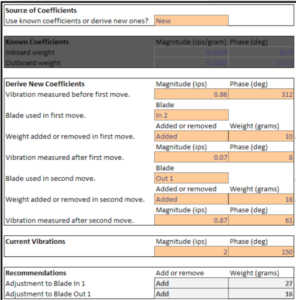Some AH-64 tail rotors are difficult to balance. The current Modern Signal Processing Unit (MSPU) software uses one set of coefficients for all aircraft, but some aircraft are significant outliers from the rest of the fleet. These aircraft behave according to coefficients that differ from the default coefficients in both magnitude and phase. This leads to the need for many moves to balance a tail rotor. RMCI has developed a methodology and program that can significantly reduce this burden on the soldier.
 The AH-64 tail rotor is a relatively simple rotor system. The only rotor smoothing adjustments are adding or removing weights from the ends of the blades. There are two coefficients, one for the inboard blades and one for the outboard blades. Because the blades are non-orthogonal and the two coefficients are different in magnitude, there is no simple conversion between adjustments recommended by the MSPU and optimum adjustments for outlier aircraft.
The AH-64 tail rotor is a relatively simple rotor system. The only rotor smoothing adjustments are adding or removing weights from the ends of the blades. There are two coefficients, one for the inboard blades and one for the outboard blades. Because the blades are non-orthogonal and the two coefficients are different in magnitude, there is no simple conversion between adjustments recommended by the MSPU and optimum adjustments for outlier aircraft.
Outlier aircraft often exhibit a greater response to adjustments than do nominal aircraft, and the phase of their response differs. This causes the vibrations to spiral or “walk around” the polar chart as the user applies the MSPU recommendations. To prevent this, it has become common practice for some units to always use half the recommended weight. Clearly, this is not an ideal solution. While it often helps reduce the number of moves required to balance an outlier aircraft, it increases the number of moves required to balance a nominal aircraft.
While the outlier aircraft have different coefficients from the rest of the fleet, each one consistently responds according to its own coefficients. Therefore, the most direct solution for balancing outlier aircraft is to use a tool that can make recommendations based on custom coefficients. RMCI has developed such a program that provides custom coefficients using two single-blade moves and provides recommendations based on these coefficients. This tool is designed to facilitate rapid deployment, provide a simple interface, and leverage existing software.
